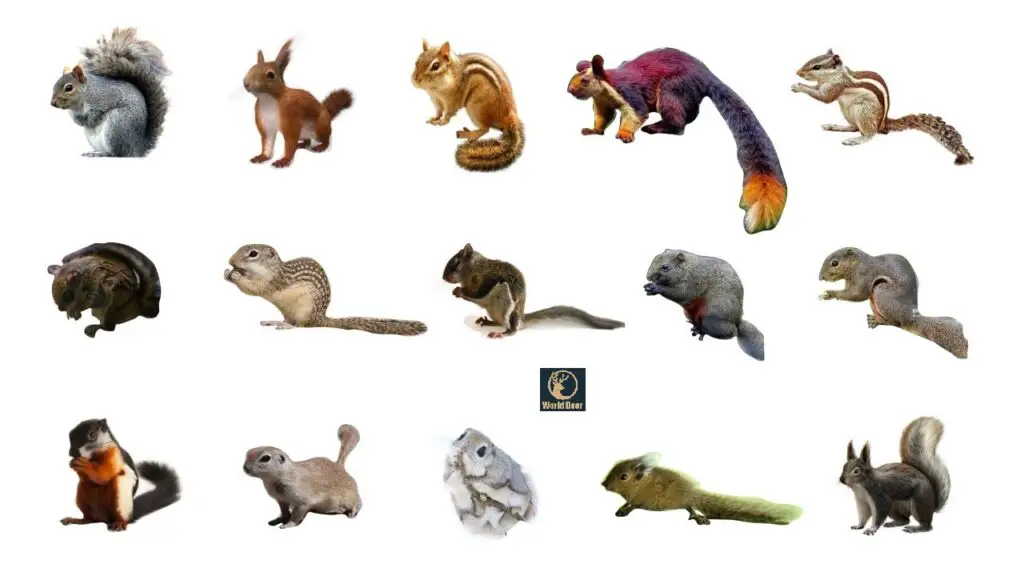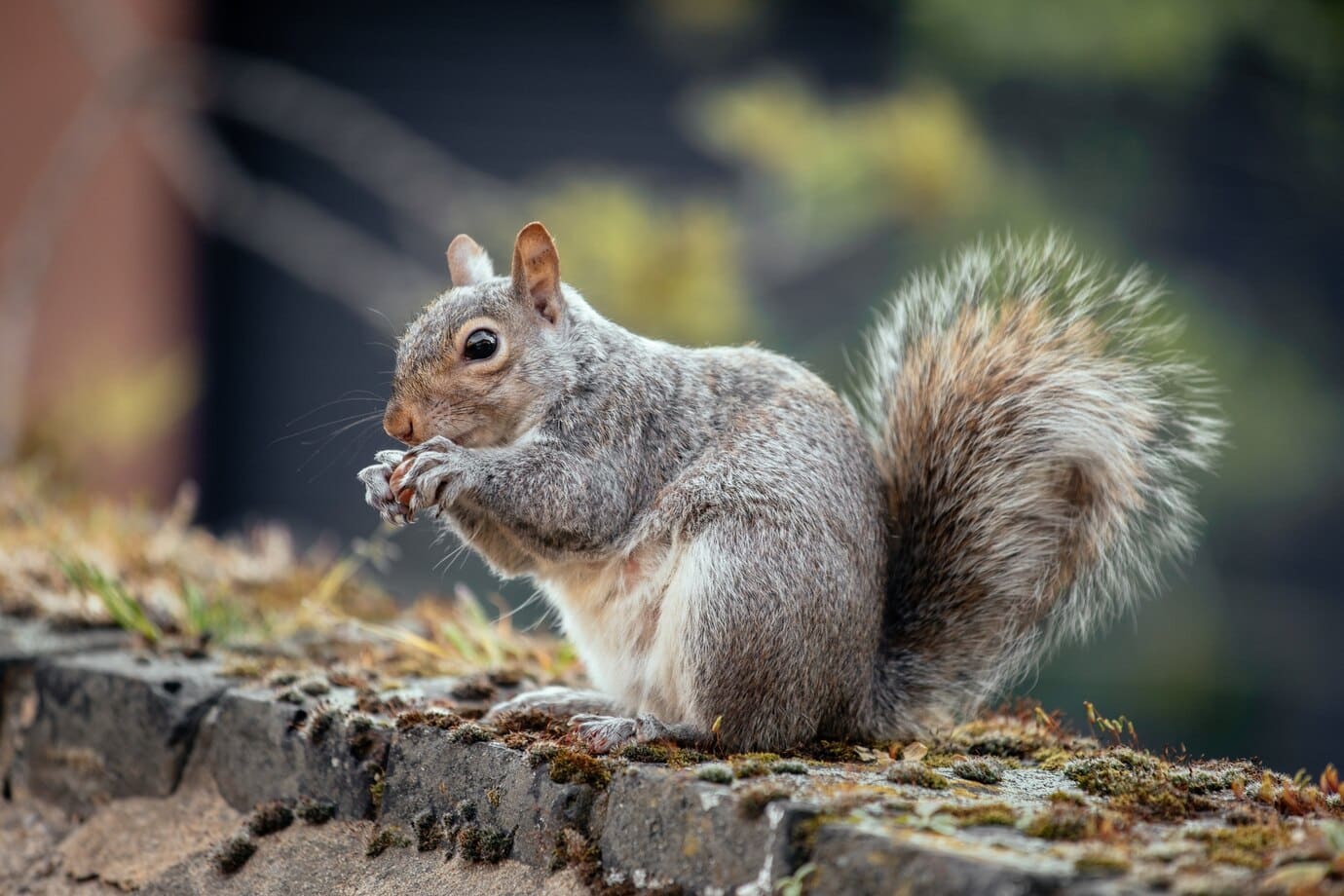SQUIRRELS
Squirrels are flexible, mischievous, and playful creatures. They belong to the largest mammalian order, Rodentia. Squirrels are small to medium-sized rodents with chisel-like incisors.
They have large, shiny eyes and a question mark-shaped, bushy tail. They are friendly by nature and often interact well with humans.
Scientific Classification of Squirrels
|
Kingdom |
Animalia |
|
Phylum |
Chordata |
|
Class |
Mammalia |
|
Order |
Rodentia |
|
Family |
Sciuridae |
Types of Squirrels
Squirrels fall in the Sciuridae family where marmots, chipmunks, and prairie dogs also lie.
According to the Integrated Taxonomy Information System (ITIS), squirrels are more than 200 species all over the world. They are classified into three categories.
These categories further break into many types of squirrels, such as antelope, gray, albino, mountain tree, African striped, fox, pygmy, Hainin flying, arctic ground, red, white, black, and sun squirrels.

Description
Size and Weight: The size of squirrels varies between different types. Pygmy squirrels are small, with a length of 8 inches and a weight of 10 grams. Medium-sized gray squirrels are about 20 inches long and weigh between 0.50 to 0.70 kg. The tail extends the length of a squirrel. Giant squirrels are 30 to 35 inches long and weigh between 1 to 1.5 kg.
Dentition: Squirrels have ever-growing, chisel-like incisors for gnawing and cheek teeth for grinding. There is a wide gap between the incisors and cheek teeth called the diastema.
Eyes: They have large, shiny eyes positioned on the top of their head, which help them observe most of their surroundings at once.
Limbs: The hind limbs are longer than the forelimbs. They have four to five toes and pointed claws for climbing and grasping.
Tail: The bushy, question mark-shaped tail benefits squirrels by protecting them from hot and cold conditions and acting like a parachute when they jump from trees.
Speed: Squirrels are agile creatures, with a running and climbing speed of up to 32 km per hour.
Coloration: Squirrels have fur on their body and tail. The most common color is shades of gray, but it varies among different species. White, black, red, brown, yellow, and rusty colors are also found in squirrels.

Squirrels Size and Weight

Squirrels walking on Limbs

Squirrels Speed and Tail
Distribution and Habitat
Squirrels are widely distributed across the Americas, Eurasia, and Africa. They are found in almost every part of the world except Australia and Antarctica. Tree squirrels tend to live in woodlands, where they make nests in trees. Squirrels prefer to live in areas with 50 to 75 nut and shelter trees. Squirrels feed on nut trees such as:
- Oak trees
- Hickory
- Walnut trees
- Maple trees
- Pecan trees
- Elm trees
- Mulberry trees
Ground squirrels, as their name suggests, dig burrows and live underground in the soil. Flying squirrels live in tree holes and crooks. They glide from tree to ground and from ground to tree with the help of their wings.
Diet and Digestion
Squirrels are considered omnivores because they eat both plants and meat. Squirrels prefer to eat proteins, carbs, and fats because they cannot digest cellulose. They primarily feed on plants such as nuts, seeds, fruits, conifer cones, fungi, and green leaves.
They can also eat small insects, bird eggs, and even young snakes. When vegetation is scarce, especially in severe summers or late winter, they may consume other rodents and small birds. Squirrels need water, but not in large amounts, as the food they eat typically meets their hydration needs.
Behavioral Adaptations
Foraging Behavior
Tree and ground squirrels are diurnal, while flying squirrels are nocturnal. They collect nuts, gnaw them, and throw them on the ground to break them open for eating. They bury the collected nuts underground or beneath the leaf litter as storage for winter.
These forgotten nuts and seeds often sprout or germinate in humid environments. This is why squirrels are called the gardeners or seed planters of nature. To counter this situation, some squirrels, like Hainin and particolored flying squirrels, hang nuts or mushrooms on trees.
Social Hierarchy
Ground squirrels are social creatures and form well-developed colonies underground. Adult males dominate smaller males. Females are subordinated by males, but after producing a litter, this subordination ends. Tree and flying squirrels tend to live in solitary environments and are not as social as ground squirrels.
Territorial Behavior
Squirrels are highly territorial. They mark their territories with scent or by tail wagging. Female squirrels fiercely protect their dens and boundaries when raising their young. Territorial disputes can lead to severe fights with potentially fatal outcomes. They also chatter at others to signal that they should stay away from their home range.
Camouflage
Squirrels are furry animals with varying colors, which helps them blend into their environment as camouflage. Their fur can be brown, red, gray, yellow, orange, white, or black.
Defensive Mechanism
When a squirrel senses danger while foraging, it can escape at speeds of up to 14 mph. Tree squirrels can flatten their bodies and become motionless until the predator leaves. They also alert other squirrels by wagging their tails and vocalizing.
Reproduction and Lifespan
Squirrels mate during the summer or spring. A female can mate with different males throughout her life, and it is up to the female to choose her mate. Copulation lasts for about 30 seconds.
The gestation period is 42 to 45 days. A female gives birth to 2 to 9 young per litter. Baby squirrels are born blind and naked. The mother squirrel cares for the young for about 10 weeks.
Male squirrels reach sexual maturity at 11 months, while females reach it at 15 months. The average lifespan of an adult squirrel is six years. In the wild, a squirrel may live up to 12 years, while in captivity, it can live up to 20 years.
Natural Predators
Squirrels have many types of natural predators, including flying predators, ground predators, and tree predators.
- Flying predators include hawks, owls, eagles, and falcons.
- Ground predators include foxes, bobcats, raccoons, coyotes, and mountain lions.
- Pine martens, like badgers and weasels, live both in trees and on the ground and are predators of squirrels.
Other mammalian predators, such as domestic cats, dogs, weasels, badgers, and minks, will eat squirrels whenever they get a chance.
Mortality Rate and Lifespan
25% percent of squirrel species die within the first year of birth. The lifespan of a male squirrel is about 2 to 3 years, while a female squirrel lives for 4 to 6 years. The annual mortality rate of squirrels is 75 percent.
Causes of Death: Falling out of trees is a common cause of death for squirrels. Young squirrels often fall from nests and die. Every year, about half of all squirrels die due to this cause.
Diseases and Cure
Squirrel poxvirus is a significant wildlife disease with a 100% mortality rate. It can be transmitted through biting insects and infected small rodents and is primarily found in Red squirrels.
Metabolic Bone Disease (MBD) is also a concern, causing squirrels to sleep more and become less active, avoiding climbing or jumping. There are many other diseases that are harmful to these small rodents. Various antibiotics and vaccines have been developed for squirrels.
Economic importance
Squirrels are economically important, particularly for Native Americans. They were used as a food source, with 2.5 million squirrels harvested each year, generating $12.5 million, which was beneficial for the economy.
Hunting squirrels is also done for their fur, but it is not as valuable as rabbit fur. Additionally, squirrels play an important role in plant succession by dispersing seeds.
Wildlife tourism in the UK is particularly attractive to tourists because the Red Squirrel is native only to the United Kingdom. Tourists are captivated by its beauty and appreciate Nature.
Conservation Status and Efforts
According to the International Union for Conservation of Nature (IUCN), red squirrels are listed as an endangered species. They are only found in the United Kingdom, with only 40,000 red squirrels remaining.
They can be conserved with the public’s help. Conservation efforts are also needed for tree squirrels, as they require mature trees in tropical and temperate regions.
Interesting Facts
- Nature designed ever growing incisors for squirrels to gnaw the nuts easily and never nubs.
- A squirrel may jump up to 20 feet long.
- Squirrels have rotating ankles 180 degrees to help them in climbing trees.
- Squirrels have athletic power as they run 32 km per hour.
- Flying squirrels can glide like bats.
FAQs- Frequently Asked Questions
Q- What do squirrels eat?
Squirrels mostly eat nuts, seeds, fruits, leaves, flower buds, and cones but sometimes eat other rodents and insects due to food scarcity.
Q- How do squirrels communicate?
Squirrels may communicate by vocalizations such as squeaks and clucks, by body language, and tail waving. Social greetings are shown by tail waving.
Q- What is a group of squirrels called?
A group of squirrels is called a dray or a scary.
Q- Where do squirrels live?
Squirrels tend to live in every habitat, including forestlands, woodlands, tundra, pastures, etc, except dried deserts and high polar regions.
Q- How many teeth do squirrels have?
A squirrel has 10 teeth, including ever growing incisor and cheek teeth.
Learn More About Squirrels
On this page, you are invited to browse our articles about some of the fascinating ways that squirrels behave.
These articles answer common questions about squirrels, including what they eat, when they’re most active, their reproductive cycle and process, and how they interact with humans in various environments.
Scroll down to learn more about some of the unique things that squirrels do and discover why they act the way they do.
